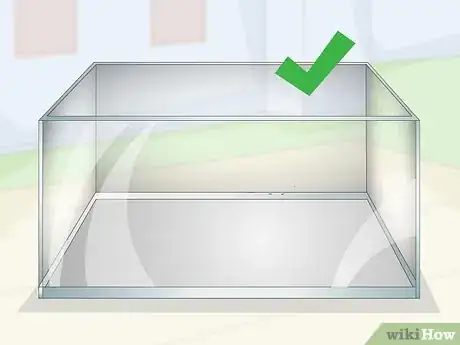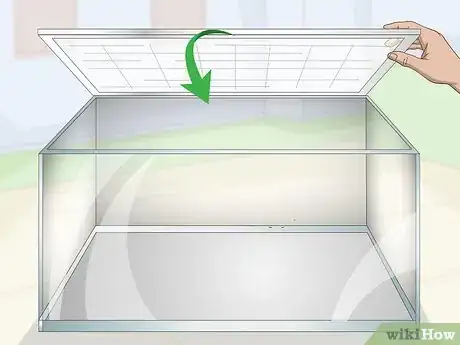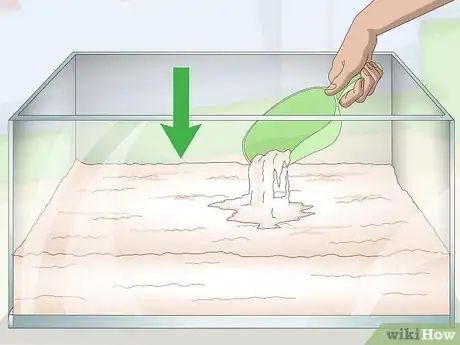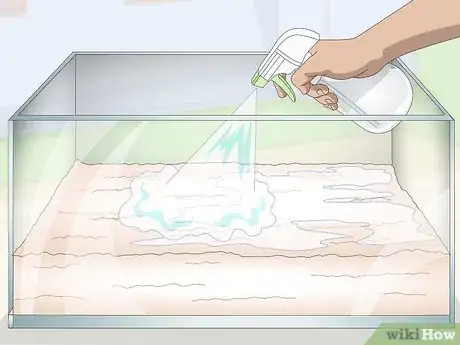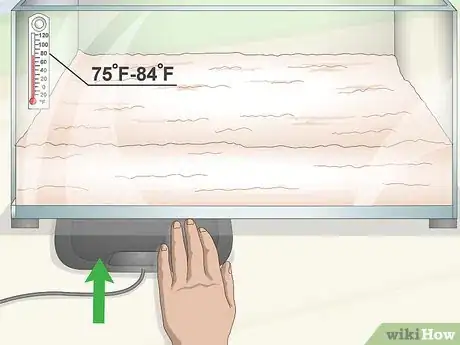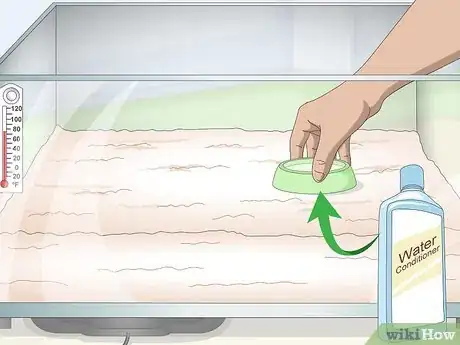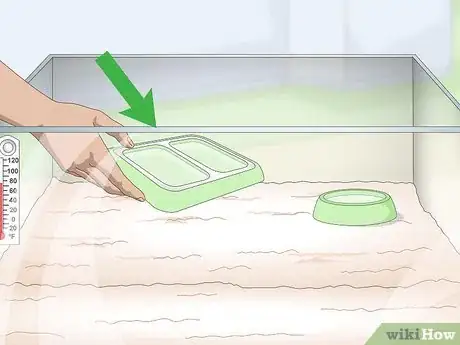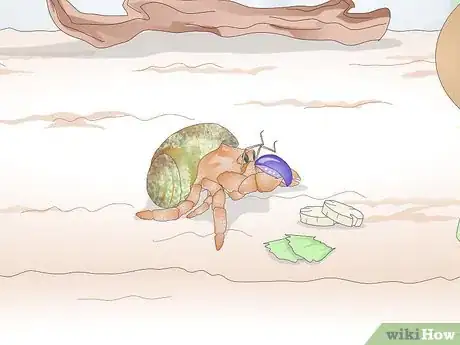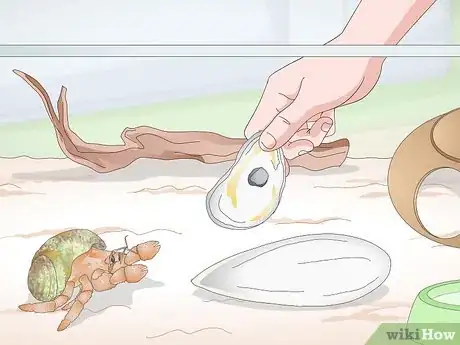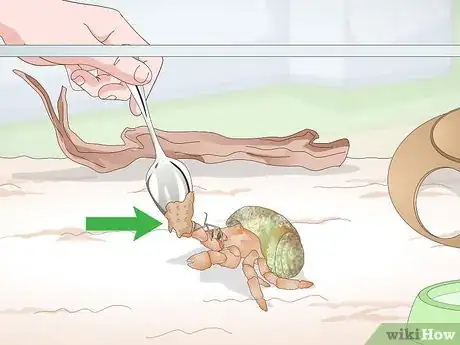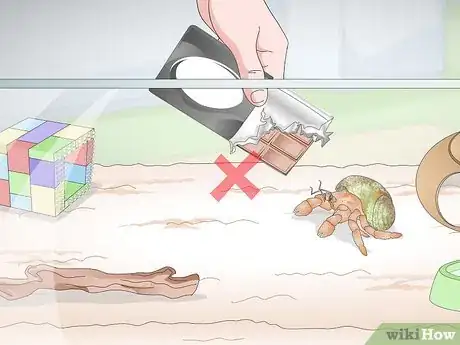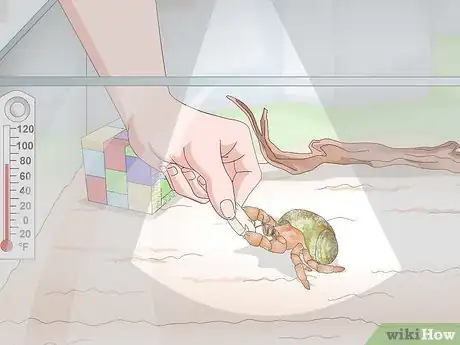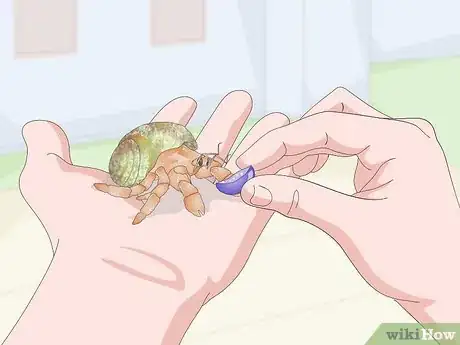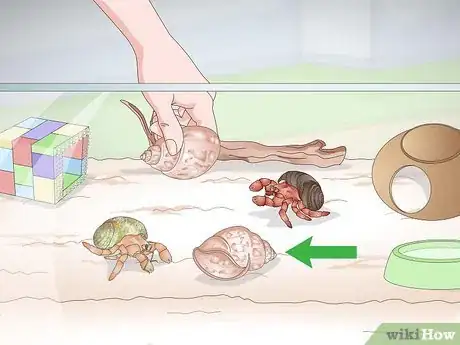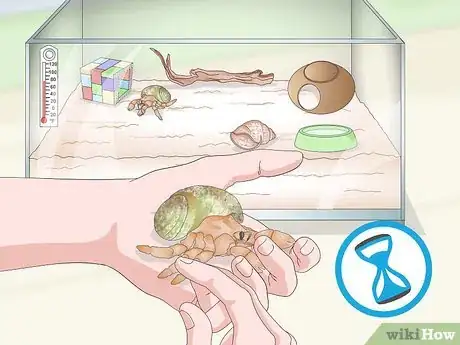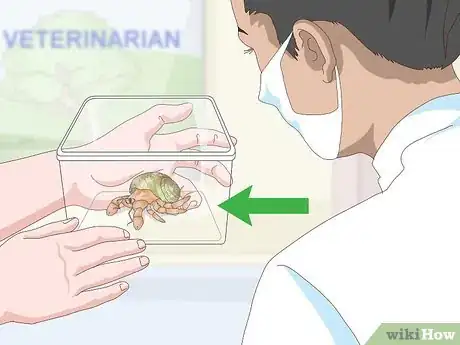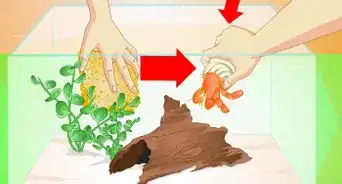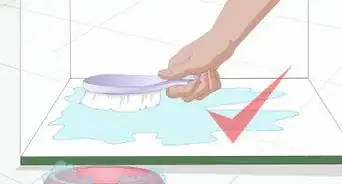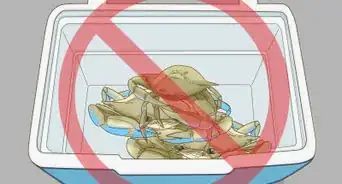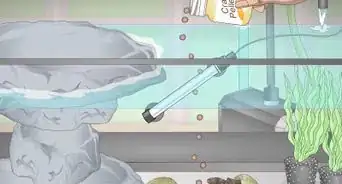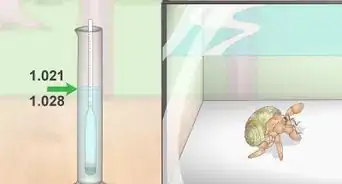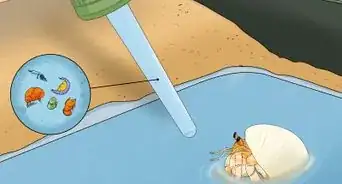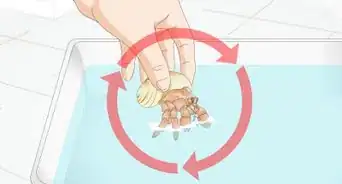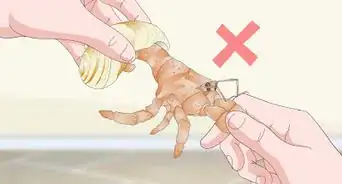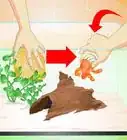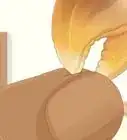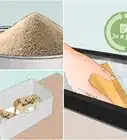This article was co-authored by Marshall Stephens. Marshall Stephens is an Aquarium Expert at Private Oceans Aquariums in West Palm Beach, Florida. Marshall has over 20 years of experience in the aquarium industry and focuses on captive-bred animals. They specialize in tropical and marine aquariums and are a contributor to the Loggerhead Marine life center in Jupiter Florida.
wikiHow marks an article as reader-approved once it receives enough positive feedback. This article received 21 testimonials and 100% of readers who voted found it helpful, earning it our reader-approved status.
This article has been viewed 168,998 times.
The land hermit crab is native to the Caribbean. You can recognize it by the large, purple claw.[1] You might have just gotten a land hermit crab, or maybe you have had it for quite some time now. Either way, you want to freshen up on your hermit crab basics and make sure your beloved pet is safe and well.
Steps
Setting up the Crabitat
-
1House your crabs in a large glass tank. The best enclosure to use is a glass aquarium. Size is a very important factor when deciding how many hermit crabs you will keep. A good rule of thumb is 1 inch (2.5 cm) of hermit crab per 1 gallon (3.8 l). To determine how long your crabs are, measure across the shell opening.[2]
- Remember, the habitat (or as many people call it, "crabitat") needs to be able to hold 3 dishes, climbing toys, shelters, shells, and have space for the crabs to walk around.
- A 10–20 US gal (38–76 l) tank usually does nicely for 3 to 4 small hermit crabs. You may want to consider starting off with at least a 30 US gal (110 l) tank. A larger tank will allow more climbing toys and more space.
- Hermit crabs, when cared for properly, can live for decades and grow very slowly to the size of a baseball. The tank size will need to increase as the hermit crabs grow.
-
2Add a secure lid to the tank. Hermit crabs are escape artists. If there is any possible way for the crabs to escape, they will almost always find it. Use a secure lid to ensure no crabs escape and that all the humidity stays in the tank.[3]
- Select a lid with small air holes installed in it.
- If your tank has a mesh lid, you can cover it with plexiglass to prevent escapes. Hermit crabs need a humid environment, so this will also keep the moisture in the tank. Be sure to leave a little bit open at each end to allow for air flow.
Advertisement -
3Fill the bottom of the tank with sand or coconut fiber. Hermit crabs require a deep substrate at least twice the height of your largest crab. The crabs will burrow themselves into the substrate to molt (shedding their exoskeleton to grow). You can use sand, coconut fiber, or a mixture of the two for your crabitat.[4]
- Medium crabs (golf ball size) need at least 8 inches (20 cm) of substrate for molting.
- Small crabs (quarter size) need 6 inches (15 cm).
- Tiny crabs (often called "micros", the size of a dime) need 4 inches (10 cm) of substrate.
- Examine the substrate carefully before putting it in the crabitat. Sift some through your fingers and check for insects. Be sure to smell it, too. Sand that smells moldy has probably been contaminated.
-
4Keep the humidity in the tank high by spraying the substrate regularly. Spray the bottom and the sides of the tank every day with dechlorinated water and keep the lid of the crabitat closed. Buy a humidity gauge at your local pet supply store and check it every day. Crabs will thrive only if the humidity is between 70-80%.[5]
- Remember that the inside of your crabitat should be like a mini-Caribbean island. It should have a moist, tropical feel to it.
- Keep the substrate at sandcastle consistency. You should be able to make a hole in it easily, but not get your fingers wet.
- Puddles of water or muddy substrate means you are misting too much.
- If you have a plastic crabitat with holes in the lid, place a warm moist towel over the lid to get an extra humidity boost inside.
- You should install a hygrometer to track humidity in a tank, which should be at 70-80% for hermit crabs.
-
5Keep the crabitat between 75 °F (24 °C) and 84 °F (29 °C). To do this, find an under tank heater or heat lamps at your local pet store. Buy a thermometer or hydrometer to measure the ambient air temperature in the tank as well.[6]
- When using a 10 US gal (38 l) tank, the best way to heat the tank is with an under the tank heater (usually referred to as a UTH). These are small pads that stick to the outside glass of the enclosure and usually raise the temperature up between 4 and 6 degrees. Try placing the unit on the bottom of the tank. Even with a thick layer of substrate the UTH will be effective.
- Heat lights work great on larger enclosures and can usually heat the tank to any temperature. A 40 watt light will do nicely on a 10 US gal (38 L) tank. Heat lights do dry out the tank very quickly, however, so you may have to spray the inside of the tank more often.
- Make sure that the heat source is placed on one side of the tank, and not in the middle. This is so the tank has a warm and cool side so the crabs can be around whatever temperature they prefer.
-
6Provide dechlorinated drinking water in a non-metallic dish. To dechlorinate drinking water for your crabs at home, buy a small bottle of tap water conditioner in the fish section of your pet store. Follow the instructions for making 1 US gal (3.8 l) of water.[7]
- Hermit crabs cannot drink tap water. This water is treated with chlorine which can cause permanent blisters on the crabs' gills.
- It's a lot easier to have a batch of water ready to use for the next few weeks or so rather than having to make a small amount every day.
- Look for a conditioner that removes chlorine and chloramine and neutralizes heavy metals.
-
7Set up dishes with dechlorinated freshwater and saltwater for bathing. Hermit crabs like to drag themselves into their water dish to sit and bath themselves sometimes. Be sure you use non-metallic dishes big enough for your crabs to bathe in, but not so deep that your smallest crabs will drown in them.[8]
- If you have very large and very small crabs living together, put pebbles at the bottom of the large crab’s water dish so a small crab can have a way to get out of it if it falls in by accident.
- Always make sure there is a way for the crabs to climb out of the dishes. Put a little bit of sponge, shells, or pebbles in the dish.[9]
- You can also make your own fresh, dechlorinated saltwater. Make 1 US gal (3.8 l) of dechlorinated water using your water conditioner. Add 10 tbsp (170 g) of aquarium salt. Let the water sit overnight so the salt dissolves. Do not use table salt to make the salt water. It contains harmful iodine.
- Many crabs also drink salt water prior to molting. Providing salt water allows the hermit crab to choose what kind of water it would like to drink.
-
8Add decor, hiding places, and toys. Use fish or reptile decor to add decoration and hiding places for the crabs. Make sure that they have large enough openings for a crab to easily enter and exit. Provide various plants and structures for the crabs to climb on.[10]
- You can use coconut huts, ceramic flower pots, large shells, reptile caves, fish decor and many other things as potential shelters.
- Pieces of wood, Lego structures, cork bark, fake or live plants, rocks, large coral, barnacle clusters, and fish décor all make great climbing structures.
- Avoid using evergreen wood in the crabitat, as it annoys the hermit crabs.
- Try creating a second level to the crabitat by using a shower caddy stuck to the glass walls of the tank. Fill it with moss or coconut fibre. Add a branch to act as a ladder for the crabs to climb up.
- Prop up a large branch into a corner and drape it with fake plants so that it acts as a tree which the hermit crab will enjoy hiding in.
Feeding Your Land Hermit Crabs
-
1Feed your crabs commercial crab food daily. Feed your hermit crab a high-quality food that’s specifically made for hermit crabs. Find it in your local pet store or online. Check the label on the food to see how much to feed them each day.[11]
- You may want to alternate between several different foods. Hermit crabs love to have variety in their diet.
- Small crabs will usually need about 1 small spoonful of food per day.
- Avoid any food that contains copper sulfate or ethoxyquin.
-
2Also always add variety to your crabs’ diet with fruits, vegetables, grains, and meat. Hermit crabs are omnivorous scavengers that take advantage of any available food both in the wild and captivity. Always add natural food that they would eat in their natural habitat.[12]
- Try feeding grapes, bananas, blueberries, and apples. They love tropical fruits found in their natural habitat, like mangoes, papaya, and coconut. Avoid giving them citrus fruits, like lemons or oranges.
- All vegetables except for onions and scallions are great for crabs. They especially enjoy carrots, lettuce, and spinach.
- Try giving plain cereals, rice, pasta, unsalted nuts, and rolled oats as treats once per week. Many hermit crabs also really enjoy ground flaxseed.
- Provide small pieces of meat for your crabs on a daily basis. Hermit crabs love picking meat off of bones. Any type of meat will do: turkey, beef, duck, lobster, catfish, or grubs. Be sure the meat is unseasoned and doesn’t have any sauce, butter, salt, or oil on it. You can serve them raw or cooked.
-
3Keep cuttlebone or oyster shells in the tank to provide extra calcium. Land hermit crabs need a calcium-rich diet. Find crushed oyster shells, or cuttlebones at your local pet store. Make sure there is always some in the tank for the crabs to eat. Never use calcium sand though, as it can act like cement when wet, and can coat your crabs legs, and make it hard for them to walk. [13]
- Land hermit crabs need calcium to help their exoskeleton grow. It’s also important to help them molt.
-
4Give your crab treats occasionally. Add some treats to the crabitat a few times per month. Crabs enjoy natural peanut butter, applesauce, raisins, trail mix, and popcorn without butter or salt.
- Crabs also enjoy eating grass, oak leaves, and tree bark. Rinse them off with dechlorinated water and let them dry before you give them to the crabs.
- Be sure to look at the ingredients of what you are feeding them so you can avoid extra sugars and other unwanted items.
-
5Avoid sugary, spicy, salty or preservative-packed foods. Things like bread, chips, or chocolate all contain too much sugar, salt, iodine or harmful additives. It’s best to stick to raw ingredients for the crabs.[14]
-
6Feed the crabs at night. Hermit crabs are nocturnal, so it’s best to feed them in the evening. Try setting a timer to remind yourself.[15]
- Make feeding and cleaning part of your daily routine. Feed your hermit crabs at the same time every evening, and then take away any uneaten food the next morning. You can keep dry food in the crabitat for 2 days, but be sure to remove any fresh food daily.
- Hermit crabs eat very little and in small amounts. To put it in perspective, most hermit crabs take a few hours to eat half a cheerio. So don't think that your hermit crabs are starving, because they aren't!
-
7Hand-feed your hermit crab to increase your bond. To do this, take a small piece of your crab’s favorite food in one hand. Gently pick up the crab by its shell with your other hand and place it on your hand next to the food. Wait patiently until your crab gathers the courage to reach out for it.[16]
- Your crab may start by doing a “taste test” of the food. It will put an antenna on the food, and then stick the antenna into its mouth.
- If your crab is interested in eating, it will pinch off small bits of food with its claw and then put it in its mouth.
- If your crab isn’t hungry, it may pinch the food but not eat any of it. In this case, put it down and try again later.
Keeping the Crabs Healthy and Entertained
-
1Add shells to the crabitat so the crabs can upgrade their housing as necessary. Hermit crabs do not grow their own shell. They take them from dead gastropods like snails. In captivity, you need to ensure that there is a wide variety of shells to choose from.[17]
- You can tell if a hermit crab's shell fits if it can seal the opening of the shell with its large claw and armor leg (back left).
- As a general rule, land hermit crabs prefer shells with round openings.
- You can get inexpensive shells from craft stores. Another great place is online. Boil the shells for 20 minutes & drain them before putting them in the crabitat.
- If its legs stick out a bit and you can still see its eyes, the hermit crab will be on the market for a new shell. Simply drop some shells in the tank and the hermit crab will change when ready. You can dip the shells in salt water periodically to draw the crabs’ attention to them if you wish.
-
2Clean the crabitat often. A clean tank will keep your crabs healthy and happy. Use a kitchen strainer or fish net to strain the sand at least 3 times per week to remove crap poop, exoskeletons, and buried food. Wash the dishes with a damp paper towel every few days. Rearrange their climbing toys every few weeks to give the crabitat a new look and keep the crabs interested in them.[18]
- You should replace all the substrate every 6 months.
- Every month, take all the shells and dishes out of the crabitat and boil them in dechlorinated saltwater to kill any mold or bacteria.
-
3Bathe new hermit crabs and recently molted crabs. Although you can generally let the crabs bathe whenever they feel like it, if you are introducing a new crab to the crabitat, or one of your crabs has just emerged from molting, you should give it a quick bath. Pour some tepid, dechlorinated saltwater into a shallow dish and place your hermit crab in the water. Let it sit fully immersed in the water for about 1 minute. Then, take it out of the bath and put it in a safe, enclosed space to dry. Once it’s fully dry, you can put it into the crabitat with the others.[19]
- Try to get your hermit crab to walk down your arm or hand and get into the water himself. If that doesn’t work, gently lift him by the shell and lower him into the bath.
- Always supervise a bathing crab. It can get really active after bathing, so even if it’s sitting at the bottom of the water at one moment, it might be scurrying out and getting lost in your house in the blink of an eye.
- Your drying off area can be as simple as a cardboard box lined with paper towels to absorb the excess moisture.
-
4Keep handling to a minimum. Avoid touching or handling your hermit crabs as much as possible. It can stress them out or even cause injury if you touch a molting crab. If you must pick them up or handle them, always grab them gently by the shell.[20]
- Even if your hermit crab knows and likes you, it may still pinch you if it becomes frightened. Be sure to handle the crab gently and carefully.
-
5Consult a veterinarian if you see signs that your crab is sick. Hermit crabs don’t get sick very often. However, if you notice signs of sickness, like dry skin, or if your crabs are acting especially lethargic, they may be sick. Start by isolating the sick crabs and cleaning the whole tank. If that doesn’t solve the problem, consult with a veterinarian.
- The trip to the veterinarian may be quite stressful for the crabs, so be sure to only take them only if absolutely necessary.
Community Q&A
-
QuestionWhat does it mean if my hermit crab hides in its shell most of the time?
 Community AnswerIt's sleeping or afraid of you. Hermit crabs are more active at night and sensitive to outside movement. So, just because you don't see them moving doesn't mean they aren't. You can test this by smoothing out the sand and checking it for tracks in 24 hours; if you see little dots or lines in the sand, your hermit crab has been moving around when you're not looking!
Community AnswerIt's sleeping or afraid of you. Hermit crabs are more active at night and sensitive to outside movement. So, just because you don't see them moving doesn't mean they aren't. You can test this by smoothing out the sand and checking it for tracks in 24 hours; if you see little dots or lines in the sand, your hermit crab has been moving around when you're not looking! -
QuestionWill there be negative effects on my hermit crab if he lives alone?
 Community AnswerThey are social creatures and will be more active and healthy with at least one other crab in the tank with them. Living alone can cause stress for a crab. A stressed crab, due to any environmental factors could autotomize (self-amputate) its limbs in response.
Community AnswerThey are social creatures and will be more active and healthy with at least one other crab in the tank with them. Living alone can cause stress for a crab. A stressed crab, due to any environmental factors could autotomize (self-amputate) its limbs in response. -
QuestionDo you have to have a friend for the hermit crab?
 Community AnswerHermit crabs are social creatures, so yes, it is in their best interests to have a friend. However, do not have too many, as they may fight and you won't have sufficient room for them. Pet care brings the responsibility with it to do the right thing by the animals you're entrusted with.
Community AnswerHermit crabs are social creatures, so yes, it is in their best interests to have a friend. However, do not have too many, as they may fight and you won't have sufficient room for them. Pet care brings the responsibility with it to do the right thing by the animals you're entrusted with.
Warnings
- Don't use painted shells, the paint will chip off and can be ingested by the crabs.⧼thumbs_response⧽
- Never try to force a hermit crab out of its shell. These creatures are very strong and you will end up ripping the crab in two.⧼thumbs_response⧽
- Don’t use metallic dishes in the crabitat. Metal can be toxic to the crabs.⧼thumbs_response⧽
- Do not touch your hermit crab while it is molting or changing shells, it will come out when it's ready.⧼thumbs_response⧽
- Never take away the exoskeleton of a hermit crab, it has lots on calcium and other nutrients and it will take longer for their exoskeleton to grow back.⧼thumbs_response⧽
Things You'll Need
- Glass tank with lid
- Sand or coconut fiber
- Thermometer
- Non-metallic food bowl
- Toys for your crabs
- Hygrometer (humidity gauge)
- Spray bottle that mists, not squirts
- 3 deep water dishes
- Heat lamp or under tank heater
- Water conditioner
- Aquarium saltwater mix
- Various climbing branches or rocks
- Shelter(s) for the crabs to hide in
- Plenty of extra shells
- Lots of plants to hide in and climb on
- Sphagnum moss (optional)
References
- ↑ https://hermit-crabs.com/species.html
- ↑ http://www.plightofthehermies.org/adopt/
- ↑ http://www.plightofthehermies.org/adopt/
- ↑ https://www.hermit-crabs.com/care.html
- ↑ https://www.hermit-crabs.com/care.html
- ↑ https://www.hermit-crabs.com/care.html
- ↑ https://www.hermit-crabs.com/care.html
- ↑ https://www.hermit-crabs.com/care.html
- ↑ https://www.hermit-crabs.com/care.html
- ↑ https://www.hermit-crabs.com/care.html
- ↑ http://www.hermit-crabs.com/food.html
- ↑ https://www.hermit-crabs.com/care.html
- ↑ https://www.hermit-crabs.com/care.html
- ↑ https://hermitcrabparadise.com/crabcare/nutrition/food.php
- ↑ https://hermitcrabparadise.com/crabcare/nutrition/food.php
- ↑ http://www.hermit-crabs.com/food.html
- ↑ https://www.hermit-crabs.com/care.html
- ↑ https://www.hermit-crabs.com/care.html
- ↑ https://www.hermit-crabs.com/care.html
- ↑ https://www.hermit-crabs.com/care.html
About This Article
To care for a land hermit crab, keep it in a large glass tank that's filled with a thick layer of sand or coconut fiber so your hermit crab can burrow. You should also set up a heater under the tank and spray the substrate in the tank with dechlorinated water every day since hermit crabs thrive in a warm, humid environment. Also, place dishes filled with dechlorinated freshwater and saltwater in the tank for your hermit crab to drink and bathe in. To learn how to feed land hermit crabs, scroll down!
